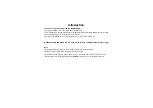
Advanced Operational Features
41-001343-02 REV05 – 07.2014
6-29
You can configure the phone to use any one of these methods by entering the applicable
v
alue in the configuration files:
Configuring the DNS Query Method
You can configure the DNS query method for the phone to use for performing DNS lookups using the following parameter
in the configuration files:
•
sip dns query type
Ignore Out of Sequence Errors
An Administrator can configure the phone via the “
sip accept out of order requests
” parameter to ignore CSeq number
errors on all SIP dialogs on the phone. When this parameter is enabled, the phone no longer verifies that the sequence
numbers increase for each message within a dialog, and does not report a "CSeq Out of Order" error if they do not
increase.
An Administrator can enable/disable this feature using the configuration files only.
Configuration
File Value
DNS Server Method Used
Description
0
A only
The phone issues requests for “
A
” (Host IP Address) records from the DNS server to get the IP
address, and uses the default port number of 5060.
1
SRV & A
The phone issues requests for “
SRV
” (Service Location Record) records from the DNS server to get
the port number. Most often, the IP address is included in the response from the DNS server to
avoid extra queries. If there is no IP address returned in the response, the phones send out the
request for “
A
” records from the DNS server to find the IP address.
2
NAPTR & SRV & A
First, the phone sends "
NAPTR
" (Naming Authority Pointer) lookup to get the “
SRV
” pointer and
service type. For example, if Global SIP transport protocol on the phone is “UDP”, and Proxy server
on the phone is “test.aastra.com”, then:
1.
If the NAPTR record is returned empty, the phone will use the default value “_sip._udp.test.aas-
tra.com" for the “
SRV
” lookup.
2.
If the NAPTR record is returned "test.aastra.com SIP+D2U .... _sip._udp.abc.aastra.co m", the
phone will use “_sip._udp.abc.aastra.com" for the “
SRV
” lookup.
3.
If the NAPTR record is returned "test.aastra.com SIP+D2T .... _sip._tcp.test.aastra.com", where
the service type TCP mismatches the phone configured transport protocol “UDP”, the phone will
ignore this value and use the default value “_sip._udp.test.aastra.com" for the “
SRV
” lookup.
Note:
The phone does not use the service type sent by the
NAPTR
response to switch its transport pro-
tocol, nor does it use the
NAPTR
response to determine whether to use a secure or unsecure com-
munication path. The phone will always use a global sip protocol that is configured on the phone
via configuration files or the web user interface.
After performing
NAPTR
, the phone sends “
SRV
” lookup to get the IP address and port number. If
there is no IP address in the “
SRV
” response, then it sends out an “
A
” lookup to get it.
Note:
On the phone side, if you configure the phone with a Fully- Qualified Domain Name (FQDN) proxy and specified port,
the phone always sends “
A only
” lookups to find the Host IP Address of the proxy.
Configuration Files
For the specific parameter you can set in the configuration files, see Appendix A, the section,
on
Note:
As the default Asterisk configuration does not fully track dialogs through a reboot, it is recommended that this param-
eter be enabled when using the BLF feature with an Asterisk server. If you do not enable this feature, then rebooting the
Asterisk server may cause BLF to stop working. With this parameter enabled, the BLF key starts working again when the
phone re-subscribes, which by default, are one hour apart.
















































